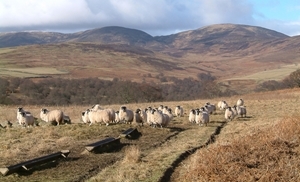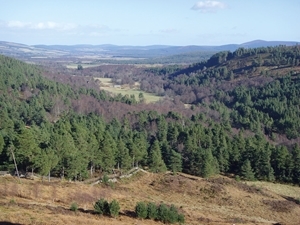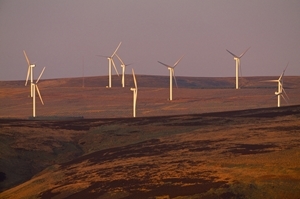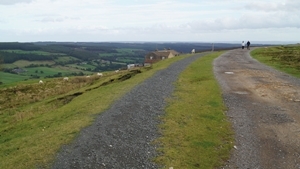Moorland is less agriculturally productive than other land and most grouse moors are classed as ‘Less Favoured Area’ (LFA) because of their lower production and distance to market. Income generation from land in these areas is mostly from:
- Game management
- Livestock grazing
- Commercial forestry
- Renewable energy generation
Game management is the only one of these that is viable without substantial public or private subsidy, and the only one that invests in maintaining high quality heather moorland. In England, the loss of heather moorland has mostly been due to agricultural improvement and overgrazing; whereas in Scotland, heather moorland has been lost because of both agriculture, grazing and forestry.
Farming
 Light, seasonal grazing by sheep can be good for heather moorland and consequently for grouse. However, subsidies for livestock farming resulted in a 30% increase in sheep on UK moorlands between the 1970s and 1990s, often leading to overgrazing. In recent years, the average density of sheep across moorland has dropped, which has improved heather cover and condition in some areas and led to undergrazing in others.
Light, seasonal grazing by sheep can be good for heather moorland and consequently for grouse. However, subsidies for livestock farming resulted in a 30% increase in sheep on UK moorlands between the 1970s and 1990s, often leading to overgrazing. In recent years, the average density of sheep across moorland has dropped, which has improved heather cover and condition in some areas and led to undergrazing in others.
A well-established effect of overgrazing is that it reduces the condition and extent of heather cover, which is typically replaced with grass-dominated vegetation. Species that require a diverse moorland habitat and those that have a strong link to heather for food and cover, such as red grouse, hen harrier, merlin and mountain hare, tend to decline in abundance and productivity with these changes. However, other species such as skylark and meadow pipit may benefit from a change to grassland provided it is not too heavily grazed.
Overgrazing by livestock can lead to soil erosion and may increase flood risk. A review from 2007 suggested that grazing can impact water flow across moorland to the extent that stopping grazing may reduce flood risk. This could be down to a variety of causes; for example, impacts on vegetation, and soil compaction from livestock trampling. Its effect on carbon capture and storage is variable and there is little impact on water quality.
A low-density, lighter grazing regime has some benefits in terms of the environment and biodiversity. The management techniques that are used to improve grazing, such as drainage and liming, can be damaging to the heather moorland and its ecosystem. However, sheep farming, especially a low-density grazing regime, is not economically viable. It needs supportive funding, either by private investment in the form of grouse management or public subsidy, perhaps in the future through agri-environment grants.
Grouse moors need sheep grazing to manage habitat and, in some places, to help control tick numbers. Sheep graziers need moorlands to summer graze their flock, thus saving their improved grass for winter, and they can benefit from nearby gamekeeping, which reduces the impacts of foxes and crows. Sheep treated with tick medication are sometimes used on moorland to attract ticks, aiming to help control overall tick numbers on the moor and reduce impact on grouse. Management arrangements between grouse moors and sheep graziers provide an incentive to manage heather moorland sustainably, maximising positive outcomes such as high nature value and rural employment, while minimising habitat damage.
Forestry
 Forestry has been one of the main causes of moorland habitat loss, with around 20% of former UK moorland now afforested with coniferous plantations. Afforestation causes an ecological transformation, in which open ground habitats and their wildlife largely disappear and are replaced by a woodland ecosystem.
Forestry has been one of the main causes of moorland habitat loss, with around 20% of former UK moorland now afforested with coniferous plantations. Afforestation causes an ecological transformation, in which open ground habitats and their wildlife largely disappear and are replaced by a woodland ecosystem.
Afforestation of the Southern Cheviots in southern Scotland is a good example of the impact of forestry on moorland birds. 15 years after planting, the forest canopy closed, and many species disappeared. The losses for that area alone were estimated to be 1,750 pairs of curlew, 1,200 pairs of golden plover, 200 pairs of dunlin, 25 pairs of merlin, and all the red grouse, snipe, redshank, wheatears, ring ouzels and hen harriers. Given that commercial forestry is growing, especially across Scotland, this situation is likely to be seen more often, particularly if grouse moor management becomes more challenging for landowners.
GWCT research into impacts of land use change in southwest Scotland also indicate that large-scale changes in land use, including afforestation, more intensive farming and reductions in grouse moor management, are responsible for declines in several bird species, including oystercatcher, golden plover, lapwing and curlew. One study in Scotland suggested that afforestation accounted for 58-78% of the decline in black grouse numbers in the region.
The mix of bird species in woodland is largely dependent on which trees are dominant and bird densities are lower in uniform woodland such as forestry plantations. Bird communities in the surrounding moorland can be affected up to a kilometre from the forest edge because of increased predation pressure, with reductions in golden plover and dunlin numbers, and reduced curlew breeding success. The introduction of forestry blocks into previously open moorland landscapes also fragments the remaining habitat, which can impact wildlife.
Beyond impacts on biodiversity, the most important effect of forestry is on soils and water. Before trees are planted, drains are often dug and fertiliser applied, which affects the nutrient composition of the soil and increases carbon release. As peatland soils store a large amount of carbon, the drainage, aeration and disturbance when areas are afforested leads to a period of carbon loss, which may not be compensated for by the growth of young trees.
A recent paper found that at sites forested both 12 and 39 years ago, loss of carbon from soil cancelled out the carbon taken up into the trees from the air and the amount of carbon stored at these sites overall did not increase. At one of the four forested sites there was an overall carbon loss. Peatland drainage for forestry lowers the water table, causing peat to shrink as it dries out and changing the habitat, which reduces its value for birds and other wildlife. This drying process accelerates once the tree canopy closes and can lead to large-scale cracking of the peat, sometimes occurring some distance away from the forestry block itself. Streams that drain afforested areas tend to be more acidic and have higher levels of nitrogen. Water flow is also affected, with total peak flow increasing initially where land has been drained then reducing once the trees mature, after perhaps 20 years.
Renewable energy
 The UK’s commitment to increasing renewable energy production is critical for reaching net zero carbon emissions. However, building wind farms on moorland affects its habitats, soil, and the wider landscape. The main impacts on moorland habitats are from the loss of land for tracks, crane hard standings, turbine bases, control buildings, borrow pits and changes in drainage. One study found the density of some moorland bird species near wind farms was reduced by between 15% and 48%. Another found that the impact of wind farms on moorland birds may be highest during the construction phase, with lower numbers of red grouse and curlew during construction.
The UK’s commitment to increasing renewable energy production is critical for reaching net zero carbon emissions. However, building wind farms on moorland affects its habitats, soil, and the wider landscape. The main impacts on moorland habitats are from the loss of land for tracks, crane hard standings, turbine bases, control buildings, borrow pits and changes in drainage. One study found the density of some moorland bird species near wind farms was reduced by between 15% and 48%. Another found that the impact of wind farms on moorland birds may be highest during the construction phase, with lower numbers of red grouse and curlew during construction.
Photo credit: Laurie Campbell
Where forested areas are felled to return an area to moorland (albeit with turbines) for renewable energy generation, over time this could be beneficial in enhancing overall biodiversity. One study suggests some species such as skylark and stonechat may benefit from the habitat change. Where income from the windfarm is reinvested in surrounding moorland the increased management and small-scale scrub planting could benefit some species. Providing renewable energy is a main priority for the country with clear benefits that must be weighed up against ecological damage.
Tourism
 Tourism is an area of increasing interest as an income source for some upland landowners and is extremely important to rural economies more widely. The potential for generating revenue on a large scale to replace the main land uses is not yet known, nor are the possible ecological impacts. In general, more tourism requires more infrastructure in terms of access and services, bringing with it increased disruption, with likely consequences for breeding wildlife. Other concerns for the upland environment include higher risk of wildfires, which are already considerably more likely both in summer and at weekends and bank holidays due to increased visitor numbers.
Tourism is an area of increasing interest as an income source for some upland landowners and is extremely important to rural economies more widely. The potential for generating revenue on a large scale to replace the main land uses is not yet known, nor are the possible ecological impacts. In general, more tourism requires more infrastructure in terms of access and services, bringing with it increased disruption, with likely consequences for breeding wildlife. Other concerns for the upland environment include higher risk of wildfires, which are already considerably more likely both in summer and at weekends and bank holidays due to increased visitor numbers.
However, whilst it seems unlikely that tourism can replace the principal economic land uses for landowners, it may provide a valuable additional income stream in some areas. Increasing the accessibility of moorlands to visitors in a sensitive way also brings advantages in terms of public appreciation and understanding of these beautiful environments.
This briefing sheet draws on information from the GWCT’s 2020 Peatland Report and the Moorland Balance, which are fully referenced and available here.
- FREE Download: Understanding grouse moor management - Essential Briefing >